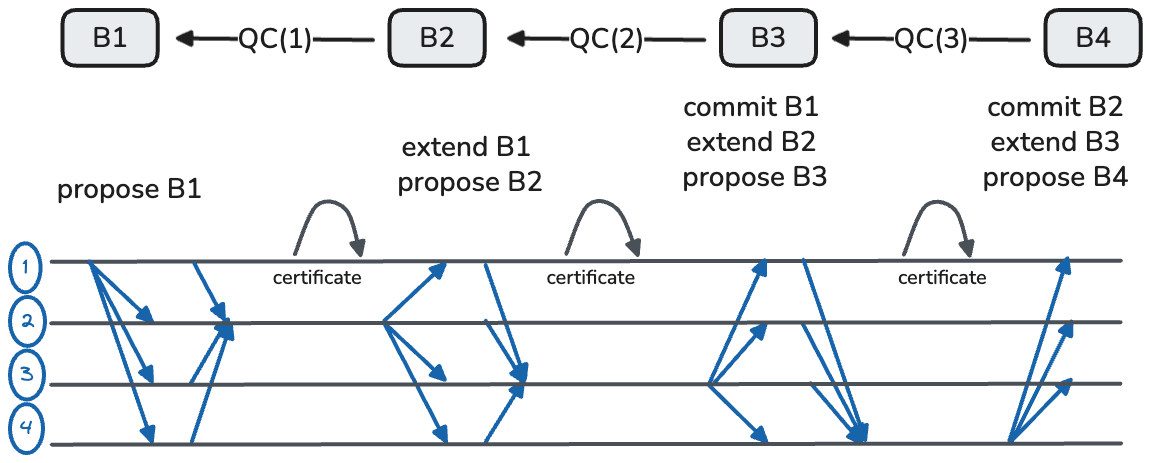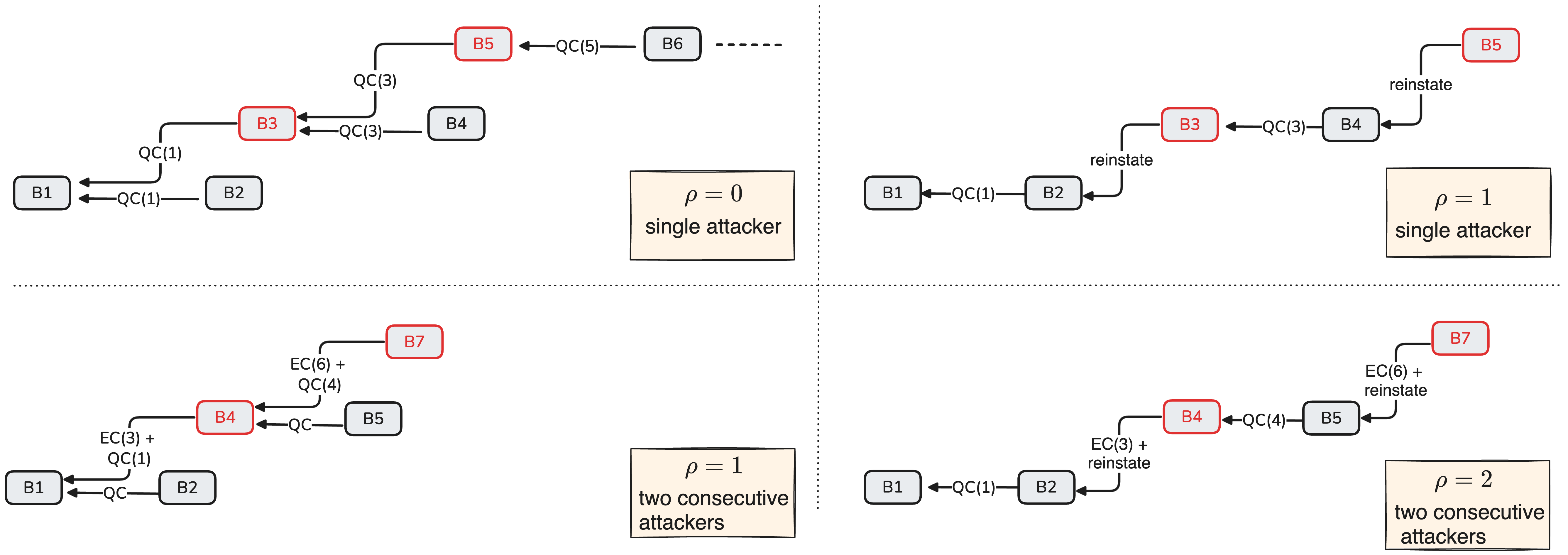The recently identified tail-forking attack shows how malicious leaders can degrade throughput by skipping over honest proposals in streamlined BFT protocols like HotStuff. To address this challenge, we introduce Carry, a lightweight mechanism that preserves HotStuff’s linearity while protecting against tail-forking. Carry also supports commits by honest-but-sluggish leaders whose messages are benignly delayed.
Synopsis
In a “streamlined” Byzantine Fault Tolerant (BFT) consensus approach, pioneered by HotStuff, the consensus protocol has a simple and uniform structure: each view is a single quorum exchange between a leader and voters, and each such exchange carries a new leader proposal. Herein lies a vulnerability exposed in BeeGees: since a single quorum exchange does not suffice to achieve a consensus decision, leaders must rely on the next leader to drive a second exchange that commits the previous proposal. In a tail-forking attack, a malicious next leader might skip over the previous leader’s proposal. Repeated attacks by bad leaders may significantly degrade throughput.
The solution presented in BeeGees is to force the next leader to prove that it extends the most recent quorum-certified proposal. This proof approach borrows from PBFT, and like it, requires either quadratic communication or computationally heavy SNARKs.
Our recent work “Carry the Tail in Consensus Protocols” introduces Carry, a lightweight, drop-in mechanism for streamlined protocols that defends against tail-forking. Notably, Carry incurs only linear communication overhead per view. Not only that, suppose a preceding leader’s proposal was benignly sluggish and did not reach all replicas in time. An honest leader in Carry seizes the opportunity to help by reinstating the sluggish proposal, without requiring a quorum of votes to certify it. In BeeGees, even if 2F honest replicas voted for the sluggish proposal, it will not commit.
Carry is a generic mechanism. We demonstrate its application to HotStuff-2 to create Carry-the-Tail (Ctail), a full consensus solution.
Overview of Ctail
Model
The setting for this work is described in the standard BFT in partial synchrony. Briefly, the system consists of N = 3F + 1 replicas with up to F Byzantine faulty, or F_actual faulty in an actual execution, F_actual ≤ F, and partially synchronous communication. (For a detailed problem model, see the Carry full paper.)
Carry is the name we give to a generic liveness-boost for protocols in the HotStuff family. A full-fledged application of Carry on HotStuff-2 which is described here is referred to as Carry-the-Tail (Ctail).
Proposing and Voting
The Ctail protocol operates in a view-by-view manner. Each view v has a known designated leader L_v performing a single quorum-exchange with replicas. The leader broadcasts a proposal B_v to the replicas; replicas respond (subject to safety rules) with a NEW-VIEW message carrying a signature-share on B_v. The signature-share is referred to as a vote on B_v.
A Quorum-Certificate (QC) consists of a threshold-signature by a quorum of 2F+1 replicas. We say that the proposal B_v is certified when a QC for it–QC(v)–is formed. To form QCs, leaders collect signature-shares for previous proposals and aggregate them. Broadcasting a QC incurs only linear word-communication complexity.
Commit Safety and Liveness
Each proposal B_v includes an opaque payload and meta-information. The meta-information references a history known to the leader. It includes B_v.QC, the highest known certified tail prior to view v. Chaining proposals to one another using cryptographic certificates is utilized along with protocol voting and commit rules to ensure safety.

Figure 1: Carry-the-tail basic flow.
Figure 1 depicts a failure-free flow of the protocol with leader proposals chained to one another via QCs. Upon receiving a proposal B_v, a replica becomes locked on B_v.QC. Locking ensures safety: in the future, the replica pledges it will only accept proposals that extend B_v.QC or a QC from a higher view.
A commit requires two consecutive successful views. If a leader L_v forms QC(v-1) for the proposal B_v-1, then the proposal becomes committed once 2F+1 signature-shares on B_v form QC(v). Anyone observing a QC on B_v, where B_v.QC = QC(v-1) learns that B_v-1 is committed. In Figure 1, B_1 and B_2 have been committed.
To guarantee liveness, a leader proposes if it received a QC from the immediately preceding view or a timeout. In the latter case, the preceding view is failed. The timeout is implemented by a separate view-synchronization (Pacemaker) module; any (linear) Pacemaker can be plugged here (e.g., RareSync, Lewis-Pye, Lumiere).
The Problem with Failed Views and Tail-Forking
The problem exposed in BeeGees is that previously, HotStuff lets a leader pretend the preceding view failed by ignoring votes for the preceding proposal. Figure 2 below shows how a malicious L_3 could exploit this and omit votes for B_2 to wrongfully skip it.

Figure 2: Without tail protection, the two cases here are indistinguishable: on left B_2 failed and is benignly skipped; and on right, B_2 is tail-forked.
More precisely, we say that a view v suffers a tail-forking attack if 2F+1 signature shares are sent by honest replicas on B_v, but the next leader L_v+1 (intentionally ignores and) does not extend B_v. Regardless of the cause, tail-forking causes significant performance degradation:
- Proposals are unnecessarily dropped.
- Commit latency increases.
- Throughput can degrade by
O(N)and latency can increase byO(N)ifFbad leaders are interspersed among honest ones (see Figure 3 below).
Carry prevents these tail-forking attacks.
Protecting the Tail
In lieu of a vote, replicas in any case must send the next leader a NEW-VIEW message indicating a timer expiration. In this case, Carry piggybacks a signature-share on an empty vote (⊥).
A leader justifies skipping over a tail B_v by attaching (in lieu of a QC) an Empty Certificate for v, denoted EC(v), consisting of a threshold signature by 2F+1 replicas on ⊥. Note that a bad leader cannot succeed in forming an EC if F+1 honest replicas voted for B_v. Figure 3 shows on the left a justified skip over B2 accompanied by EC(2).

Figure 3: With Carry protection, on left B_2 failed and it is skipped via an EC(2) justifying skipping it; on right, B_2 is reinstated.
Reinstating Uncertified Tails
If there is neither a QC nor an EC, previous solutions (e.g., BeeGees) required leaders to justify skipping the tail with a proof that incorporates information about all votes and resulted in quadratic communication per leader; faced with a worst-case cascade of F bad leaders, this could result in cubic communication.
In Carry, a leader can reinstate an uncertified tail B_v in a reinstate reference. Figure 3 shows two scenarios: on left, a justified skip accompanied by an EC; on right, a reinstated, uncertified proposal.
The new proposal inherits from B_v its own QC, EC, and/or reinstate references. Care must be taken in order to preserve safety when incorporating these references, e.g., when skipping views between the current proposal and v, and between v and the highest known QC. For details, see the Carry full paper.
We remark that the reinstating mechanism is beneficial also in case the previous leader was benignly sluggish and fell short of obtaining a full quorum or votes. Carry guarantees that even a single vote reaches an honest next leader it can reinstate it.
ρ-Tail-Resilience
Unfortunately, requiring an EC to skip only the last view would not suffice to protect an honest tail B_v against two consecutive bad leaders, L_v+1 and L_v+2: L_v+1 would not just ignore votes for B_v, it would omit proposing anything for view v+1. Therefore, replicas would send empty vote-shares for v+1 and L_v+2 would form EC(v+1) to justify skipping view v+1, but would not need to justify skipping B_v. Therefore, L_v+2 could (again) ignore votes for B_v, and propose B_v+2 that extends the highest QC preceding view v.
To protect against 2–or more generally, against ρ–consecutive bad leaders, Carry repeats the tail protection up to ρ views preceding the next leader’s view. In this way, Carry can protect a tail unless it is followed by ρ consecutive bad views with O(ρN) word communication.
More specifically, each replica piggybacks on a NEW-VIEW message its own vote-shares (possibly empty) from the last ρ views (in addition to its highest locked QC). When a leader proposes, if the highest QC it knows is at most ρ views earlier, then it must justify every skipped view back to this QC or to an interim reinstated proposal. Care must be taken to interleave reinstated proposals without blowing the communication overhead. For details, see the Carry full paper.
Figure 4 illustrates the performance degradation of carry under different choices of ρ: For ρ=0 (top left), there is no tail protection. ρ=1 (top right) provides defense against a single bad leader at a time, but (bottom left), no tail protection against two consecutive bad leaders each time. Finally, ρ=2 (bottom right) provides defense against two consecutive bad leaders each time.

Figure 4: Performance degradation under different choices of ρ.
ρ-Tail-Resilience guarantees that in each rotation of N leaders, all but (F_actual / ρ) proposals are protected from tail-forking. In practice, for modest values of ρ, the probability of ρ consecutive bad leaders is very small, especially if leader rotation is randomized.
Comparing ρ-Tail-Resilience with AHL
BeeGees defined the Any-Honest-Leader commit (AHL) property: after GST, once an honest leader proposes, that block will subsequently be committed as soon as a constant number (e.g., 3 in HotStuff-2) of consecutive views with honest-leaders occur. To achieve this, BeeGees uses a complex leader handover, with quadratic communication or computationally heavy SNARKs.
Carry’s ρ-tail-resilience guarantees that a large constant fraction of honest leader proposals, namely all except F_actual/ρ, do become committed even under worst-case tail-forking. By setting ρ = f, Carry achieves the same AHL property as BeeGees with the same communication burden. However, arguably Carry has simpler logic and also allows ρ to be a tunable parameter in production.
Additionally, an honest leader in Carry may help commit a benignly-sluggish previous proposal which did not reach all replicas. Supporting sluggish-leaders may have far-reaching performance benefits on real systems which experience transient network delays.
| honest leader commit | word comm. overhead per-view | word comm. overhead worst-case | sluggish-leader commit supported | |
|---|---|---|---|---|
| BeeGees [G+ 2022] | always | O(n²) *or SNARK | O(n³) *or O(n)-SNARKS | no |
| Carry [GKMS 2025] | All except (F_actual/𝝆) | O(𝝆·n) | O(𝝆·n²) | yes |